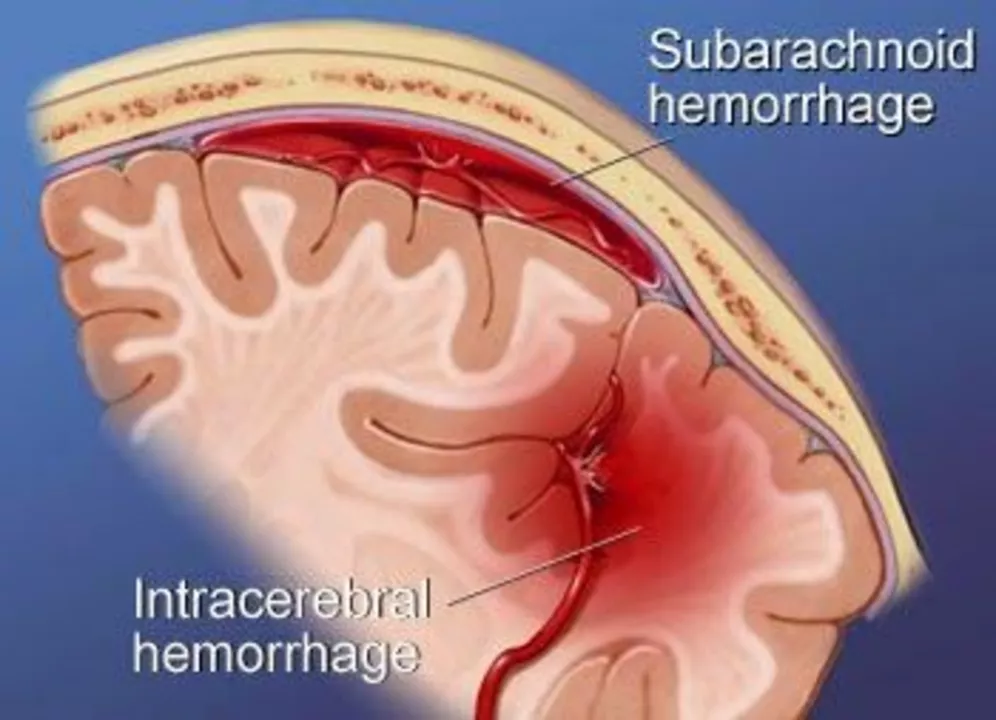Understanding Subarachnoid Hemorrhage and Brain Injuries
Subarachnoid hemorrhage (SAH) is a severe and life-threatening condition that occurs when blood leaks into the space between the brain and the surrounding membrane, known as the subarachnoid space. This can result in increased pressure on the brain, leading to various types of brain injuries. In this article, we will explore the link between subarachnoid hemorrhage and brain injuries, and discuss the various factors that contribute to their occurrence.
Causes of Subarachnoid Hemorrhage
There are several factors that can cause a subarachnoid hemorrhage, such as head trauma, ruptured brain aneurysms, and blood vessel abnormalities. Head trauma, for instance, can result from car accidents, falls, or assaults. These incidents can cause blood vessels in the brain to rupture, leading to bleeding into the subarachnoid space. In the case of brain aneurysms, these are weakened, bulging areas in the blood vessels that can rupture, causing a hemorrhage. Blood vessel abnormalities, such as arteriovenous malformations (AVMs), can also result in a subarachnoid hemorrhage if they rupture or leak.
How Subarachnoid Hemorrhage Leads to Brain Injuries
When blood leaks into the subarachnoid space, it can cause increased pressure on the brain, as well as inflammation and irritation of the brain tissue. This can disrupt the normal functioning of the brain and lead to various types of brain injuries, such as ischemic or hemorrhagic strokes, brain swelling, or even brain herniation. The increased pressure can also impair the blood supply to the brain, depriving it of essential oxygen and nutrients, leading to further damage.
Types of Brain Injuries Associated with Subarachnoid Hemorrhage
There are several types of brain injuries that can occur as a result of a subarachnoid hemorrhage. These include:
Ischemic Stroke
An ischemic stroke occurs when the blood supply to the brain is disrupted, often as a result of a blood clot or a ruptured blood vessel. In the case of a subarachnoid hemorrhage, the leaked blood can cause blood vessels to constrict, reducing blood flow to the brain and leading to an ischemic stroke.
Hemorrhagic Stroke
A hemorrhagic stroke occurs when there is bleeding directly into the brain tissue, causing damage to the surrounding cells. This can happen when a subarachnoid hemorrhage leads to a rupture of a blood vessel within the brain itself.
Brain Swelling
Brain swelling, or cerebral edema, can occur as a result of a subarachnoid hemorrhage, as the blood irritates the brain tissue and causes inflammation. This can lead to increased pressure within the skull, which can cause further brain damage.
Brain Herniation
In severe cases, the increased pressure within the skull caused by a subarachnoid hemorrhage can lead to brain herniation. This occurs when parts of the brain are displaced and pushed through openings in the skull, which can be life-threatening.
Risk Factors and Prevention
There are several risk factors that can increase the likelihood of experiencing a subarachnoid hemorrhage and subsequent brain injuries. These include a family history of brain aneurysms or SAH, high blood pressure, smoking, and excessive alcohol consumption. In order to reduce the risk of a subarachnoid hemorrhage, it is important to maintain a healthy lifestyle, including regular exercise, a balanced diet, and avoiding smoking and excessive alcohol consumption. Regular check-ups with a healthcare professional can also help in early detection and treatment of any potential issues.
Diagnosis and Treatment
Diagnosing a subarachnoid hemorrhage usually involves a combination of a physical examination, imaging tests such as a CT scan or MRI, and a lumbar puncture to analyze the cerebrospinal fluid for signs of bleeding. Once a subarachnoid hemorrhage has been diagnosed, treatment options can include medications to reduce blood pressure and prevent seizures, as well as surgical interventions to repair ruptured blood vessels or reduce pressure within the skull.
Recovery and Rehabilitation
Recovery from a subarachnoid hemorrhage and associated brain injuries can be a long and challenging process. Rehabilitation may involve physical, occupational, and speech therapy to address any deficits in strength, coordination, or communication. Emotional and psychological support may also be necessary, as individuals recovering from a subarachnoid hemorrhage may experience feelings of depression, anxiety, or frustration. A multidisciplinary team of healthcare professionals, including neurologists, therapists, and counselors, can work together to create a comprehensive rehabilitation plan tailored to the individual's needs.
Conclusion
Subarachnoid hemorrhage is a serious and potentially life-threatening condition that can lead to various types of brain injuries. Understanding the link between SAH and brain injuries is crucial in order to provide effective treatment and support for individuals affected by this condition. By adopting a healthy lifestyle, seeking regular medical care, and being aware of the signs and symptoms of a subarachnoid hemorrhage, individuals can take steps to reduce their risk and improve their chances of a successful recovery if a hemorrhage occurs.





Reviews
It is profoundly unsettling that a condition as lethal as subarachnoid hemorrhage continues to be misunderstood by the public. The sheer devastation it can wreak upon the fragile architecture of the brain demands our utmost vigilance. No amount of casual discourse can diminish the gravity of a hemorrhage that invades the subarachnoid space. The cascading cascade of pressure, inflammation, and ischemia forms a tragic symphony of injury. Let us therefore uphold a solemn commitment to education and prevention.
Honestly most of the hype around subarachnoid hemorrhage feels exaggerated and the outcomes are not always catastrophic. The article paints every case as a death sentence which simply isn’t true for many patients who survive with proper care.
Hey, great point! 🙌 Even if some cases are less severe, every bit of awareness helps us catch the serious ones early. Stay hopeful! 😊
i totally get why people get freaked out by SAH-it’s like your brain’s own fireworks show gone wrong. but honestly, with the right medics and quick action, you can definetly beat the odds. remember, knowledge is power and sharing info keeps us all safer.
Sure, because “brain fireworks” is exactly how I picture my CT scan-nothing like a casual Saturday night explosion, right?
Subarachnoid hemorrhage, abbreviated SAH, is a vascular emergency that requires rapid diagnosis and intervention. The initial bleed originates in the subarachnoid space, which lies between the pia mater and the arachnoid mater. Blood entering this space instantly raises intracranial pressure, compromising cerebral perfusion. The resulting ischemia can initiate a cascade of secondary injuries, including cerebral edema and vasospasm. Vasospasm typically peaks between days three and fourteen, narrowing arterial lumens and further restricting blood flow. In addition to mechanical compression, blood breakdown products trigger inflammatory pathways that exacerbate neuronal damage. Clinical presentation often includes a sudden “thunderclap” headache, neck stiffness, and photophobia. Computed tomography is the imaging modality of choice within the first six hours, boasting near‑perfect sensitivity. If CT is inconclusive, lumbar puncture can detect xanthochromia, confirming prior hemorrhage. Endovascular coiling and surgical clipping are the two principal methods to secure ruptured aneurysms. Medically, nimodipine is administered to mitigate vasospasm, while blood pressure control reduces re‑bleeding risk. Early rehabilitation, encompassing physical, occupational, and speech therapy, improves functional outcomes. Psychological support is equally vital, as survivors frequently battle anxiety and depression. Prognosis hinges on Hunt‑Hess grade at presentation, patient age, and promptness of treatment. Ultimately, a multidisciplinary approach maximizes survival and quality of life for SAH patients.
Just read the article and it’s a solid rundown on how SAH can mess up the brain. Nothing too fancy, just the facts.
This is exactly why we need more public health campaigns.
Ah, the human brain-so fragile yet so stubbornly resilient, like a philosopher who refuses to accept death without a debate. One could argue that subarachnoid hemorrhage is nature’s way of reminding us that we’re all on a ticking clock, but let’s be honest, we love a good drama. If you’re looking for a silver lining, consider that surviving such a catastrophe often turns people into grateful celebrators of the mundane. So cheers to the tiny vessels that dared to burst and the doctors who play heroic roles in this tragic theater.
Well said! It’s wonderful to see optimism woven into a discussion of such a serious condition. Everyone benefits when we share hope alongside hard facts.
Subarachnoid hemorrhage, undeniably, represents a critical neurological emergency, and its management, therefore, demands a coordinated, multidisciplinary approach; timely imaging, such as CT or MRI, provides essential diagnostic clarity, while interventions, including surgical clipping or endovascular coiling, aim to secure the ruptured vessel; furthermore, pharmacologic strategies, for instance, the administration of nimodipine, seek to prevent vasospasm, and comprehensive rehabilitation, encompassing physical, occupational, and speech therapy, supports functional recovery, ultimately enhancing patient outcomes.
Excellent summary, very helpful.